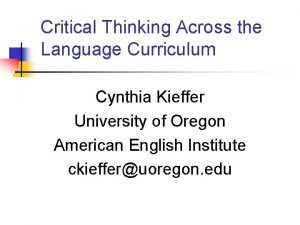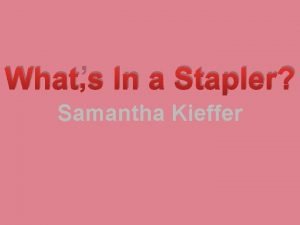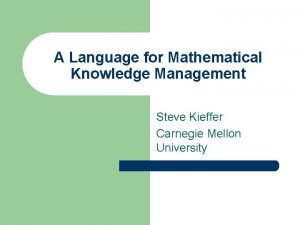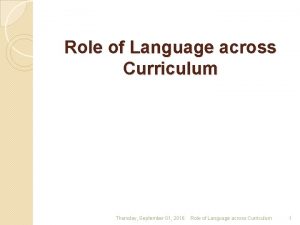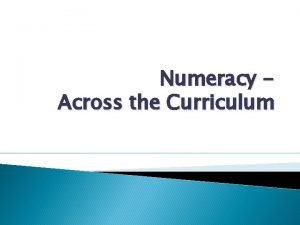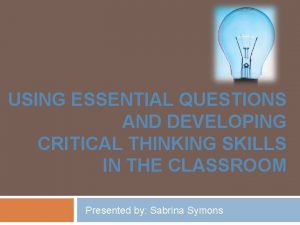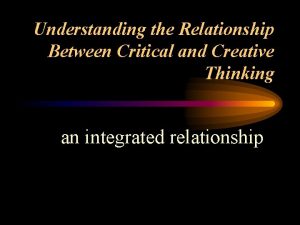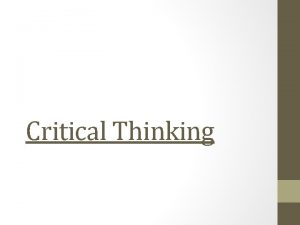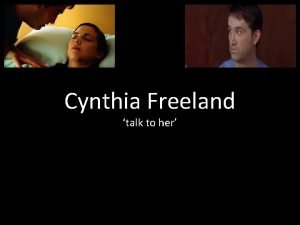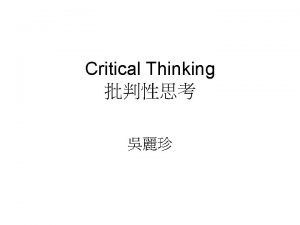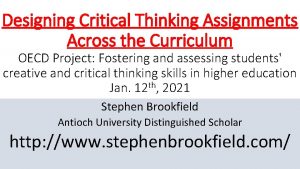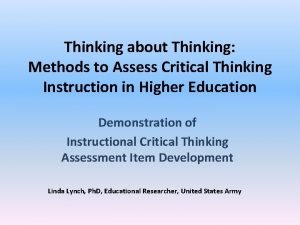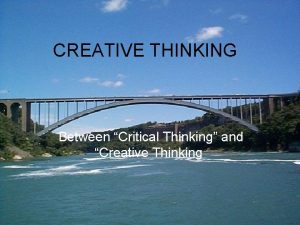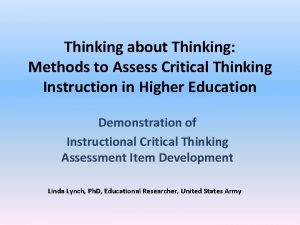Critical Thinking Across the Language Curriculum Cynthia Kieffer
















- Slides: 16

Critical Thinking Across the Language Curriculum Cynthia Kieffer University of Oregon American English Institute ckieffer@uoregon. edu

Introduction Homework anyone? n Topic I: Overview n Activity I: Textbook Analysis, A n Topic 2: Bloom’s Taxonomy n Activity 2: Textbook Analysis, B n Wrap Up, Q & A n

Topic One: Rationale for Teaching Critical Thinking In the past, we memorized facts. n Today’s global world requires that a person learn and make sense of new information through … -- multiple sources -- analysis -- synthesis -- evaluation n

Topic One: Critical Thinking is…. Reflective and reasonable thinking. n Providing and requesting evidence. n Determining authenticity, accuracy, and worth of information or claims. n A frame of mind plus a number of mental operations (processes). n

Topic One: The research shows that CT skills… Are needed in today’s world n Can be taught n Can be infused into curriculum and need not be taught as separate skills. n

Topic One: Cognitive Research, Bloom’s Taxonomy Knowledge n Comprehension n Application n Analysis n Synthesis n Evaluation n

Activity One, Textbook Analysis n n “Speed up to the World Outside” Intermediate level, Unit 1, Reading, page 12: Miguel Angel Corzo (mini-biography) Sample fact-finding questions: -- Where did he study and work? -- Read the text. How many time expressions can you find?

Activity One: Bloom’s Question Cues, 1 -2 Knowledge: define, list, tell, describe, label n Comprehension: explain, give examples, differentiate n TASK: In groups, create knowledge and comprehension questions for a biographical figure (Miguel Angel Corzo or other). n

Activity One: Debrief n n n Name of biographical figure Age of the students Question type (knowledge or comprehension) Question or activity Keep your biographical figures and questions. We will build on them in Activity Two.

Topic Two: Bloom’s Question Cues, 3 -6 Application: calculate, illustrate, classify n Analysis: compare, contrast, infer n Synthesis: substitute, what if? , reconstruct, design, invent n Evaluation: measure, recommend, convince, judge, defend, decide n

Activity Two n TASK: Now go back to the biographical figure (Miguel Angel Corzo or other), and create additional questions or activities to elicit critical thinking in these categories.

Topic Two: Bloom’s Question Cues, 3 -6 Application: calculate, illustrate, classify n Analysis: compare, contrast, infer n Synthesis: substitute, what if? , reconstruct, design, invent n Evaluation: measure, recommend, convince, judge, defend, decide n

Activity Two, Debrief Name of biographical figure n Age of the students n Question type (application, analysis, synthesis, or evaluation) n Question or activity n

Wrap Up: Teaching Implications n n Analyze and adapt materials. Develop activities that elicit higher order CT skills. Include appropriate assessment (teach and test at comparable CT levels). English + CT = meaningful communication across the curriculum.

Next Steps Critical Thinking, Part II February: “Establishing and Maintaining a Climate in the Classroom for Critical Thinking Skills. ” n See web site readings, especially --Taxonomy of Socratic Question --Strategy List: 35 Dimensions n

Critical Thinking Across the Language Curriculum Cynthia Kieffer University of Oregon American English Institute ckieffer@uoregon. edu
 Cynthia kieffer
Cynthia kieffer Critical semi critical and non critical instruments
Critical semi critical and non critical instruments Semicritical
Semicritical Perbedaan critical thinking dan creative thinking
Perbedaan critical thinking dan creative thinking Critical and creative thinking vic curriculum
Critical and creative thinking vic curriculum Janya kieffer
Janya kieffer Samantha kieffer
Samantha kieffer Myriam kieffer
Myriam kieffer Steve kieffer
Steve kieffer Michael kieffer nyu
Michael kieffer nyu Language across the curriculum conclusion
Language across the curriculum conclusion Numeracy across the curriculum audit
Numeracy across the curriculum audit Slidetodoc.com
Slidetodoc.com Which is the hardest
Which is the hardest Critical thinking guidelines
Critical thinking guidelines Critical thinking examples
Critical thinking examples Relationship between creative and critical thinking
Relationship between creative and critical thinking
